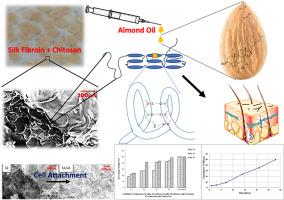丝基冷冻凝胶抗菌3D支架,促进伤口愈合
IF 4.7
3区 材料科学
Q2 MATERIALS SCIENCE, MULTIDISCIPLINARY
引用次数: 0
摘要
包括溃疡和烧伤在内的皮肤损伤影响着全球数百万人,给个人和医疗保健系统带来沉重负担。组织工程已经成为开发先进生物材料来解决烧伤和溃疡相关并发症的一种有前途的方法。本研究主要研究了添加杏仁油的丝素蛋白(SF)和壳聚糖(CS)支架在伤口愈合、感染预防和皮肤组织再生等方面的应用前景。利用冷冻凝胶技术,制备了SF/CS复合支架,并进行了综合化学(FTIR)、物理(孔隙度、密度、膨胀性能、药物释放和降解性能)和生物学评估(体外细胞研究)。在研究的配方中,富含10%杏仁油的支架表现出最佳性能,其孔隙率为21%,密度降低(20.5 mg/L),溶胀能力提高(72小时后达到962%),并且随着时间的推移,药物释放和支架降解持续(28天内达到20%)。添加杏仁油的复合支架具有抗菌活性、生物相容性、增强细胞粘附和增殖能力等特点。支架还表现出细胞迁移的改善,这是伤口愈合的关键特性。为期7天的细胞活力研究表明,与丝绸、壳聚糖或丝绸/壳聚糖支架相比,细胞活力显著增加(97%)。研究结果强调了10%杏仁油结合的SF/CS支架作为一种有前途的皮肤组织再生生物材料的潜力。本文章由计算机程序翻译,如有差异,请以英文原文为准。

Silk based freeze gelated antibacterial 3D scaffolds for enhanced wound healing
Skin injuries, including ulcers and burns, affect millions globally, imposing substantial burdens on individuals and healthcare systems. Tissue engineering has emerged as a promising approach for developing advanced biomaterials to address burns and ulcers related complications. This study focuses on fabricating and characterizing silk fibroin (SF) and chitosan (CS) scaffolds supplemented with almond oil for potential applications in wound healing, infection prevention and skin tissue regeneration. Utilizing the freeze gelation technique, composite SF/CS scaffolds were fabricated and subjected to comprehensive chemical (FTIR), physical (porosity, density, swelling properties, drug release, and degradation properties), and biological assessments (in-vitro cell studies). Among the formulations examined, scaffolds enriched with 10 % almond oil exhibited optimal properties, showcasing a desirable porosity of 21 %, reduced density (20.5 mg/L), heightened swelling capacity (962 % after 72 h), and sustained drug release and scaffold degradation over time (up to 20 % in 28 days). The new composite scaffold supplemented with almond oil demonstrated antibacterial activity, biocompatibility, enhanced cell adhesion and proliferation. The scaffold also exhibited improved cell migration which is the key property for wound healing. The seven-day cell viability study suggested a significant increase (97 %) as compared to silk, chitosan, or silk/chitosan scaffolds. The findings underscore the potential of SF/CS scaffolds integrated with 10 % almond oil as a promising biomaterial for skin tissue regeneration.
求助全文
通过发布文献求助,成功后即可免费获取论文全文。
去求助
来源期刊

Materials Chemistry and Physics
工程技术-材料科学:综合
CiteScore
8.70
自引率
4.30%
发文量
1515
审稿时长
69 days
期刊介绍:
Materials Chemistry and Physics is devoted to short communications, full-length research papers and feature articles on interrelationships among structure, properties, processing and performance of materials. The Editors welcome manuscripts on thin films, surface and interface science, materials degradation and reliability, metallurgy, semiconductors and optoelectronic materials, fine ceramics, magnetics, superconductors, specialty polymers, nano-materials and composite materials.
 求助内容:
求助内容: 应助结果提醒方式:
应助结果提醒方式:


